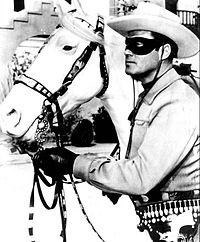“Return with us now to those thrilling days of yesteryear, when from out of the past come the thundering hoof beats of the great horse Silver! The Lone Ranger rides again!”
With those resonating words, and against the orchestral strains of music from Rosini’s “William Tell Overture”, millions of America’s children – and probably, just as many adults – gathered around their radios three times a week to welcome one of America’s most revered heroes into their homes. Originating from the studios of WXYZ in Detroit, Michigan and eventually carried by 150 radio stations around the country, this most-honored example of radio drama during the Golden Age of such entertainment endured for 2956 episodes between April, 1933 and September, 1954.
For the benefit of later generations who might not know the genesis of the characters and the mythology which brought them together, let’s take a moment to go back into “the thrilling days of yesteryear”. Even avid listeners of the day might not necessarily have known that the story all began when six Texas Rangers were gunned down in a criminal ambush. A Native American named Tonto happened along and discovered that one of the Rangers was still live. By coincidence, the survivor – Dan Reid, whom Tonto would nurse back to health – was the same man who had saved Tonto’s life in the past. Together, they dug not five, but six graves, inventing the fiction that Dan together with his brother John Reid was dead. Thus, he becomes the “masked man” in his war on crime and search for the ambushers.
Except for a few early episodes, the lead role was played by a Michigan actor named Earle Graser, from April 1933 until his death in a highway accident in April, 1941. I was eight years of age when news of his death finally trickled down to me, and like kids all over America, I felt as if I had lost a special friend. While I understood that this was only the actor who had died, I was still devastated. Every time we passed a highway accident in our own family travels, I would be reminded of the “Lone Ranger” I had grown up with. Even after Brace Beemer transitioned (slowly, and with the help of a microphone gimmick) into the new “Masked Man”, it wasn’t quite the same. Beemer had a deeper voice and looked more the part he would play for the next 13 years, and became well known as The Lone Ranger, even into the days of television.
After the days of television, Jay Silverheels would play the part of Tonto, and it was my privilege to get to know him personally as we shared a booth space at a Los Angeles convention around 1970.
The writers and producers of the long-running radio series held to a code from which they never departed: There was no smoking, drinking or swearing, and no scene ever involved a saloon; there was no glamorizing of the “bad guys”, who were usually known by a nick name, with no reflection on any minority identity. The Lone Ranger adhered to precise speech and correct grammar – no accent or local jargon; and respected the virtues of being prepared mentally and physically. The scripts honored love of country, friendship and the need to make the world better in some way. The “Masked Man” never shot to kill, but to disarm the bad guy. Parents of the 30s and 40s didn’t have to worry about what their kids would be exposed to when the “Lone Ranger” and “Tonto” were allowed into their homes.
P.S. A radio “spin-off” of this classic drama featured a nephew of the fictional Dan Reid’s son whose name would be Britt Reid or . . .”The Green Hornet”.
Actor Clayton Moore played the "Lone Ranger" when
television required more than a great radio voice.





No comments:
Post a Comment